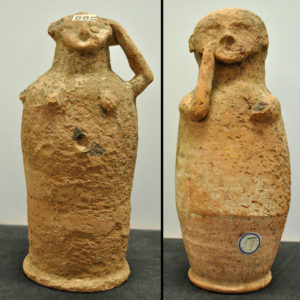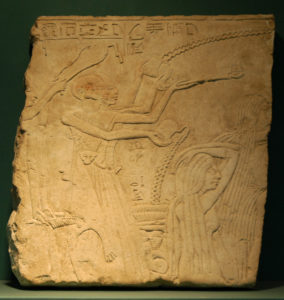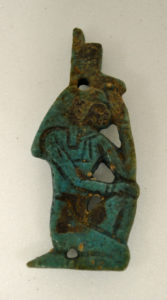Gestures of grief: Mourning and the funeral procession
By Emily Millward, University of Birmingham
Mourning is the process by which grief (most often due to bereavement) is expressed through both verbal and non-verbal communication. There is a wealth of both literary and visual evidence demonstrating how the ancient Egyptians expressed grief, particularly during the funeral procession. From the moment that the funerary cortège departed from the western riverbank of the Nile members of the entourage would begin to mourn, adopting specific gestures and attitudes to express their emotion.

Two ceramic figurines in the form of mourning women. Unknown provenance, 11th Dynasty. Birmingham Museum and Art Gallery, left, 1969W2132; right, 1969W2131. Photographs courtesy of Carl Graves.
The majority of visual evidence of mourning during the funeral procession comes from decorative scenes adorning the tombs of the nobles on the West Bank at Thebes (Millward 2012: 141). Largely dating to the New Kingdom many of these scenes display the entire funeral procession from the entourage departing in the funerary barges to the final rites performed outside the tomb before interment. The most complete depiction of the funeral procession is recorded in the 18th Dynasty tomb of Neferhotep (TT49) (Davies 1973: pl.xxiii). Throughout the scene mourners consistently appear expressing their sadness and loss by adopting certain gestures. These can be identified as ‘typical’ in that they appear consistently over a wide chronological period and with great frequency (Millward 2013: 45). These typical gestures of mourning include raising the arms aloft, pulling at hair and exposing the breasts. As noted above, the majority of sources relating to mourning date to the New Kingdom, however such typical gestures of grief are seen as early as the Old Kingdom. For example in scenes of the funeral procession in the tomb of Pepi-ankh at Meir (Blackman 1924: pl.lxii) and continuing into the Middle Kingdom, as two ceramic figurines from Birmingham Museum and Art Gallery (BMAG) exhibit (1969W2132 and 1969W2131).

Relief fragment from the tomb of Hor-nankht showing the ‘Opening of the Mouth’ ritual, limestone, Seventeenth – 18th Dynasty. Birmingham Museum and Art Gallery 1966A688. Photograph courtesy of Adam Jaffer.
Below left, mourning amulet in the form of Isis, Third Intermediate Period. Eton College Myers Collection ECM148. Photograph courtesy of Carl Graves.
 Although mourners were part of the funerary entourage and therefore expected to keep pace with the cortège as it proceeded towards the tomb, they are not always shown to be standing. In many tomb depictions mourners are shown kneeling to the ground, often to throw dust or dirt over their faces in a less common expression of loss; the latter is rendered in the tomb of Ramose (TT55) (Davies 1941: pl.xlix). A similar kneeling posture combined with the typical gestures of grief is regularly adopted by mourners in scenes depicting the final rites of the funeral procession, namely the Opening of the Mouth ritual which can be seen in 1966A688 from BMAG. Kneeling is also a common position adopted by figures in mourning within different artistic mediums, including a variety of amulets representing the goddesses Isis and Nephthys, the mythological mourners par-excellence. These amulets (for example ECM148) would have been placed on the chest of the deceased during embalming and generally show the goddesses with one hand raised aloft and the other resting on their bent knee. These amulets emphasise the formulaic nature of mourning in ancient Egypt and they demonstrate the consistency of expressions of grief cross-contextually from each episode of the funeral.
Although mourners were part of the funerary entourage and therefore expected to keep pace with the cortège as it proceeded towards the tomb, they are not always shown to be standing. In many tomb depictions mourners are shown kneeling to the ground, often to throw dust or dirt over their faces in a less common expression of loss; the latter is rendered in the tomb of Ramose (TT55) (Davies 1941: pl.xlix). A similar kneeling posture combined with the typical gestures of grief is regularly adopted by mourners in scenes depicting the final rites of the funeral procession, namely the Opening of the Mouth ritual which can be seen in 1966A688 from BMAG. Kneeling is also a common position adopted by figures in mourning within different artistic mediums, including a variety of amulets representing the goddesses Isis and Nephthys, the mythological mourners par-excellence. These amulets (for example ECM148) would have been placed on the chest of the deceased during embalming and generally show the goddesses with one hand raised aloft and the other resting on their bent knee. These amulets emphasise the formulaic nature of mourning in ancient Egypt and they demonstrate the consistency of expressions of grief cross-contextually from each episode of the funeral.
Further reading
Blackman, A.M. 1924. The Rock Tombs of Meir: Part IV, the Tomb Chapel of Pep’onkh. London.
Davies, N. de G. 1941. The Tomb of the Vizier Ramose. London.
Davies, N. de G. 1973. The Tomb of Neferhotep at Thebes. New York.
Millward, E. 2012. ‘Visual and written evidence for mourning in New Kingdom Egypt’, in H. Abd El Gawad, N.Andrews and M. Correas-Amador (eds), Current Research in Egyptology 2011: Proceedings of the Twelfth Annual Symposium, Durham University 2011, Oxford, 141-146.
Millward, E. 2012. ‘Actions speak louder than words’: Gestures of Communication in Ancient Egypt. In C. Graves and S. Gregory (eds.), Connections: Communication in Ancient Egypt. Birmingham.
Millward, E. 2013.‘Mourning of the Deceased: An Overview of Current Research into the Gestures and Attitudes of Grief in Ancient Egypt’, Rosetta 12.5: 43-50.
